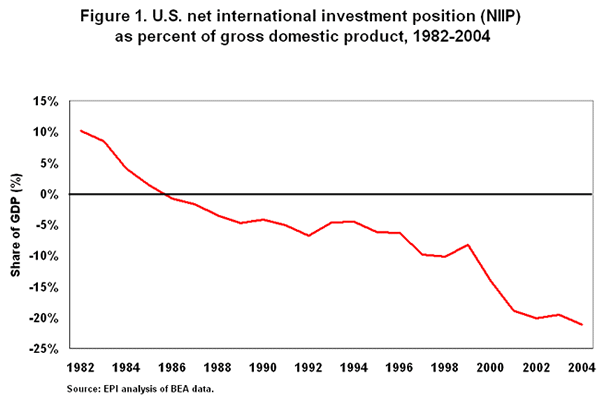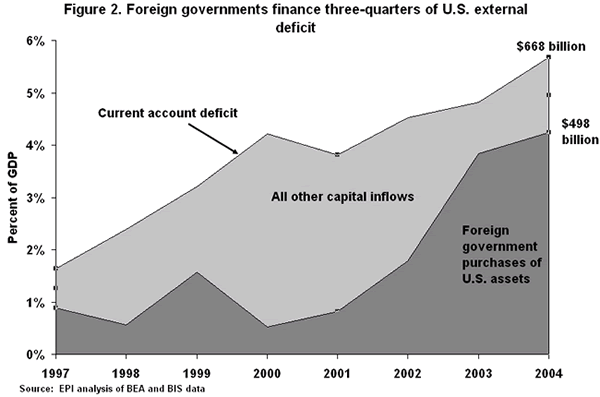See Snapshots Archive.
Snapshot for June 30, 2005.
Foreign liabilities are rapidly increasing, especially to foreign central banks
Mounting trade deficits have caused the United States to incur rapidly growing obligations to foreign investors according to the new report by the Bureau of Economic Analysis. To finance the nation’s trade deficits, the United States must sell off more of its assets to foreign investors or reduce the stock of U.S. assets held overseas. The net effect is a rapidly deteriorating net international investment position (NIIP). The U.S. NIIP, measured as a share of total gross domestic product (GDP), deteriorated sharply from 1982 through 2004 as the asset sales necessary to finance trade deficits transformed the United States from the world’s strongest international asset position to the world’s largest liability position. Earlier this week, data from the organization of the world’s central banks showed that foreign central banks are financing 75% of our trade deficit.
As recently as 1985, the United States still had more assets than liabilities abroad. Since then, the U.S. NIIP has deteriorated so substantially that the value of foreign holdings in the United States now exceeds that of U.S. holdings abroad by 21.2% of GDP, about $2.5 trillion in 2003. U.S. NIIP as a share of GDP has followed a declining path since the early 1980s (Figure 1). In addition, most projections of international economic activity show that the U.S. trade deficits and negative asset position will continue to grow rapidly in coming years unless the United States takes steps to slow their growth or foreign investors limit the flows of new capital to the United States.

The NIIP measures the value of assets Americans own abroad, minus the value of assets here in the United States owned by foreign entities. Changes in the NIIP each year reflect several factors, including the capital flows needed to finance the current account, the change in asset prices, and movements in exchange rates. On a positive note, the NIIP report revealed that the declining value of the dollar causes the value of U.S. assets abroad to rise in dollar value. As a result, the U.S. NIIP has not fallen as much as its current account deficit. U.S. private investors had foreign currency assets of $6 trillion in 2004. As foreign currencies gained value, American investors experienced gains of about $230 billion.
Nonetheless, the rapid growth of the U.S. current account deficit raises concerns about the future stability of the U.S. dollar. The U.S. had a current account deficit of 5.7% in 2004. When countries develop such large trade deficits and net liabilities, private lenders ultimately become less willing to finance those deficits.
A new report from the authoritative Bank of International Settlements (BIS)—the international organization of the world’s central banks—shows that foreign central banks financed 75% of the U.S. current account deficit in 2004, providing an inflow of $498 billion (Figure 2). 1 The BIS estimate of the official reserve transactions was about 26% larger than the Bureau of Economic Analysis estimate of these flows ($395 billion) because a growing share of these reserves are held by private third-party brokers in transactions that are not reported to the BEA.2 Official reserve transactions by foreign central banks were somewhat larger than the net deterioration of NIIP. Foreign governments served as the lender of last resort to the United States in 2004, as they did in 2003. Most of that capital came from China, Japan, and other Asian countries, which sought to reduce pressure on their currencies to appreciate against the dollar. Without that intervention, the dollar, which declined 5.8% in 2004 in real terms, would have fallen more rapidly than it did. Were the dollar to decline, the competitiveness of U.S. export- and import-competing industries would improve, and production and jobs in industries in manufacturing and other sectors would strengthen.

The longer the dollar value remains high, the greater the risk of a sudden break in the dollar, which would be disruptive to U.S. financial markets and interest sensitive industries at huge costs to the economy. The best way to avoid this threat is to bring about a large (i.e., 40%), sustained reduction in the real, trade-weighted value of the dollar. Such a reduction would lower import growth, increase exports, and reduce the trade deficit. By intervening in U.S. currency markets to prevent dollar and trade adjustment, Asian governments are raising the risk of serious disruption to the economies of the United States and the rest of the world.
(For additional analysis of the effect of foreign government intervention on the value of the dollar, see the Snapshot, U.S. current account deficit continues to grow to record high, updated with new data on June 17, 2005.)
References
[1] 2005. BIS 75th Annual Report (April 2004– March 2005). Basel: Bank for International Settlements. June 27. http://www.bis.org/publ/ar2005e.htm
[2] Higgins, Mathew and Thomas Klitgaard. 2004. “Reserve accumulation: implications for global capital flows and financial markets.” Current Issues in Economics and Finance. September /October, p 8. http://www.newyorkfed.org/research/current_issues/ci10-10.pdf
Today’s Snapshot was written by EPI economist Robert E. Scott with research assistance by David Ratner.
